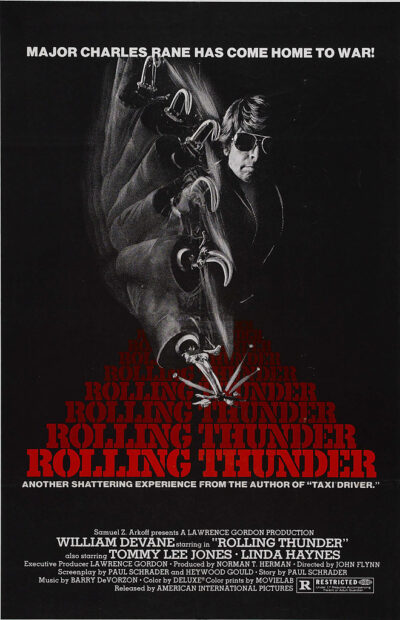 A Paul Schrader scripted grindhouse epic, about a Vietnam veteran on a revenge spree, that was heavily rewritten. Directed by the late action specialist John Flynn (1932-2007), ROLLING THUNDER (1977) actually turned out far deeper and more thoughtful than the Schrader script (readily available online). It remains one of the finest films of its kind, offering up naturalistic drama and brutal action in equal doses, and satisfying in both categories. As an otherwise negative NEW YORK TIMES reviewer conceded, “Though ROLLING THUNDER appears to have been made primarily for what is loosely called “the action market”…it has a nice feeling for the way small-town America looks and sounds and it has several excellent performances,” while Quentin Tarantino has dubbed it “the best combination of character study and action film ever made.”
A Paul Schrader scripted grindhouse epic, about a Vietnam veteran on a revenge spree, that was heavily rewritten. Directed by the late action specialist John Flynn (1932-2007), ROLLING THUNDER (1977) actually turned out far deeper and more thoughtful than the Schrader script (readily available online). It remains one of the finest films of its kind, offering up naturalistic drama and brutal action in equal doses, and satisfying in both categories. As an otherwise negative NEW YORK TIMES reviewer conceded, “Though ROLLING THUNDER appears to have been made primarily for what is loosely called “the action market”…it has a nice feeling for the way small-town America looks and sounds and it has several excellent performances,” while Quentin Tarantino has dubbed it “the best combination of character study and action film ever made.”
As with the Coming Home themed films that came before it (WELCOME HOME SOLDIER BOYS, MY FRIENDS NEED KILLING), ROLLING THUNDER wasn’t much of a success. It has, however, undergone a cult rediscovery, spearheaded by Tarantino (who appropriated from it the name and hook logo of his short-lived Rolling Thunder Productions).
William Devane, in a performance Robert De Niro would be hard-pressed to top, plays Major Charles Rane, who’s just returned to his Texas hometown after six years of internment in a Vietnamese prison camp. In a departure from most films of this type, the first half-hour deals with Devane’s relationships with his family, and does so with admirable focus. His wife Janet (Lisa Blake Richards) has a found a new beau in the form of Cliff (Lawrason Driscoll), a cop who’s become a surrogate father to Rane’s young son Mark (Jordan Gerler).
Then one day some rednecks, led by a creep known as Automatic Slim (Luke Askew), invade Rane’s house looking to steal the money he received upon returning home. They torture him, which brings back some extremely vivid memories, and eventually grind up his right hand in the garbage disposal of the kitchen sink. Rane, channeling his wartime stoicism, refrains from revealing the location of the money, frustrating the scumbags, who shoot Janet and Mark.
Emerging from a hospital a couple weeks later, Rane, now sporting a hook in place of his lost hand, hits the revenge trail. He takes Linda (Linda Haynes), a local hottie who claims to have worn Rane’s ID bracelet while he was in Vietnam, with him on a trip to Mexico. There he tracks down Automatic Slim and manages to wound him before being chased off. Cliff, meanwhile, tries to head off Rane but is killed by Mr. Slim, shortly after which Linda is abandoned by Rane—who tracks his tormentors, Slim included, to a sleazy whorehouse, and recruits Johnny Vohden (Tommy Lee Jones), a fellow veteran, to help finish them off.
Many of the details of Paul Schrader’s original screenplay may have been altered—Rane’s trip to Mexico, for starters, was more concretely fleshed out by Schrader, whereas onscreen it feels perfunctory and implausible (how exactly did Rane know where his tormentors would end up?)—but his fingerprints are all over the finished film, from the tortured hero’s early attempts at coming to terms with the world around him to the explosive final shootout.
In true Schrader fashion, the violence of that shoot-out serves as a redemption for the fractured hero, who (in another Schrader trademark) finds he can only fully express himself through violence. That fact is underlined by the fact that Devane apparently omitted a great deal of Rane’s dialogue, creating an unnervingly introspective individual whose mental state is tantalizingly mysterious; his revenge spree may have been score settling or simply a way to stave off boredom.
The drama is punctuated with violent, though never overly so, action sequences. The nastiest scene, the hand grinding, is pulled off with notable restraint (close-ups of the hand being mutilated were filmed but edited out after test audiences complained), explaining why the ultra-graphic final shoot-out, which does admittedly feel a bit out of place, was so widely criticized (the fact that it’s set in a brothel greatly upset many commentators—as a WASHINGTON POST reviewer whined, “ROLLING THUNDER is undoubtedly Spawn of Peckinpah, but some of its kinkier wrinkles might shock the originator himself”). That ending does, however, provide a rousing TAXI DRIVER-esque capper.
Credit must also go to the supporting cast, whose standout members include a young Tommy Lee Jones, the criminally underutilized Linda Haynes (1947-2023) and the always-formidable character actor Luke Askew (1932-2012) as Automatic Slim, a villain whose menace is enhanced by his unassuming air. I’ll also praise stunt coordinator Billy Burton, who, it’s been claimed, accomplished the stunt-packed finale almost entirely without actual stuntmen.
Vital Statistics
ROLLING THUNDER
American International Pictures
Director: John Flynn
Producer: Norman T. Herman
Screenplay: Paul Schrader, Heywood Gould
Cinematography: Jordan Cronenweth
Editing: Frank P. Keller
Cast: William Devane, Tommy Lee Jones, Linda Haynes, James Best, Dabney Coleman, Lisa Blake Richards, Luke Askew, Lawrason Driscoll, James Victor, Cassie Yates, Jordan Gerler, Jane Abbott, Jerry Brown, Jacque Burandt, Anthony Castillo, Charles Escamilia
